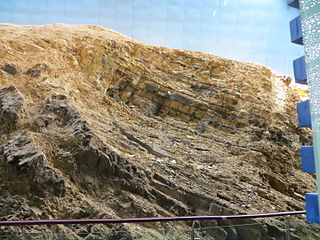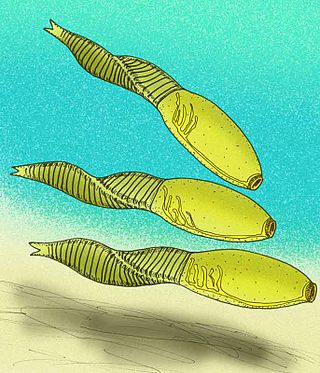
Vetulicolia is a group of bilaterian marine animals encompassing several extinct species from the Cambrian, and possibly Ediacaran, periods. As of 2023, the majority of workers favor placing Vetulicolians in the stem group of the Chordata, but some continue to favor a more crownward placement as a sister group to the Tunicata. It was initially erected as a monophyletic clade with the rank of phylum in 2001, with subsequent work supporting its monophyly. However, more recent research suggests that vetulicolians may be paraphyletic and form a basal evolutionary grade of stem chordates.

The Maotianshan Shales (帽天山页岩) are a series of Early Cambrian sedimentary deposits in the Chiungchussu Formation, famous for their Konservat Lagerstätten, deposits known for the exceptional preservation of fossilized organisms or traces. The Maotianshan Shales form one of some forty Cambrian fossil locations worldwide exhibiting exquisite preservation of rarely preserved, non-mineralized soft tissue, comparable to the fossils of the Burgess Shale of British Columbia, Canada. They take their name from Maotianshan Hill in Chengjiang County, Yunnan Province, China.

Yunnanozoon lividum is an extinct species of bilaterian animal from the Lower Cambrian Chengjiang biota of Yunnan province, China. Its affinities have been long the subject of controversy.

Vetulicola is an extinct genus of marine animal discovered from the Cambrian of China. It is the eponymous member of the enigmatic phylum Vetulicolia, which is of uncertain affinities but may belong to the deuterostomes. The name was derived from Vetulicola cuneata, the first species described by Hou Xian-guang in 1987 from the Lower Cambrian Chiungchussu Formation in Chengjiang, China.

Didazoon haoae is an extinct species of vetulicolid vetulicolian described by Shu, et al. based on fossils found in the Qiongzhusi (Chiungchussu) Formation, Yu'anshan Member, Lower Cambrian, in the Dabanqiao area (Kunming), about 60 km northwest of Chengjiang, China.

Pomatrum is an extinct vetulicolian, the senior synonym of Xidazoon; the latter taxon was described by Shu, et al. (1999) based on fossils found in the Qiongzhusi (Chiungchussu) Formation, Yu'anshan Member, Lower Cambrian, Haikou, (Kunming), about 50 km west of Chengjiang, China.

Banffia is a genus of animals described from Middle Cambrian fossils. The genus commemorates Banff, Alberta, near where the first fossil specimens were discovered. Its placement in higher taxa is controversial, with it mostly being considered to be a member of the enigmatic phylum Vetulicolia.

Vetulicolida is a class of vetulicolians. It consists of the order Vetulicolata and the genus Nesonektris, which is of uncertain placement. It is distinguished from the Banffozoa by the number and size of posterior segments as well as features of the anterior section.

Vetulicolidae is a vetulicolian family from the Cambrian Stage 3 Maotianshan Shale and Sirius Passet Lagerstätte that consists of Vetulicola, Beidazoon, and Ooedigera. It is distinguished from the Didazoonidae by a harder body wall and the lack of an oral disc.

Didazoonidae is a vetulicolian family within the order Vetulicolata. It is characterized by a relatively thin-walled, non-biomineralized body and a large, round anterior opening surrounded by an oral disc. It may be paraphyletic, even if the phylum Vetulicolia is monophyletic.

Banffozoa is an extinct class of bilaterians. Most workers place it in the Vetulicolia, but the protostome-like features of some members have motivated ongoing debate. Banffozoa consists of the order Banffiata as well as a dwarf "Form A" that has not been formally described or named. Skeemella has been placed incertae sedis in this class, but has more recently been placed with the Banffiidae. Banffozoa may be paraphyletic even if Vetulicolia is monophyletic.

Yuyuanozoon magnificissimi, from the Cambrian Stage 3 Chengjiang lagerstatte, is the largest known vetulicolian, with specimens up to 20 cm in length compared to 5–14 cm for other vetulicolian species.

Vetulicola cuneata is a species of extinct marine animal from the Early Cambrian Chengjiang biota of China. It was described by Hou Xian-guang in 1987 from the Lower Cambrian Chiungchussu Formation, and became the first animal under an eponymous phylum Vetulicolia.

Skeemella is a genus of elongate animal from the Middle Cambrian Wheeler Shale and Marjum lagerstätte of Utah. It has been classified with the banffozoan vetulicolians.

Nesonektris aldridgei is an extinct vetulicolian from the Late Botomian-aged Emu Bay Shale Lagerstätte in Kangaroo Island, Australia. So far, it is the fourth described vetulicolian that is not restricted to the Maotianshan Shales.

Beidazoon venustum is a marine deuterostome from the group Vetulicolia. It originates from the lower Cambrian Chengjiang biota of Yunnan Province, China, and was discovered in 2005. It is known as the smallest described vetulicolian, and for its surface being covered in many small nodes.

Banfiidae is a family of extinct banffozoan animals from North America and China. The family name is sometimes spelt Banffidae. It includes Banffia, Heteromorphus, and possibly Skeemella. The family may be paraphyletic. The family may be paraphyletic. A Heteromorphus-like dwarf "Form A" is allied with this group at the class level, but has not been formally described or assigned to this family.

Vetulocystis is an extinct genus type genus of the family Vetulocystidae. It was found in the Maotianshan Shales, which date to roughly 518 mya.
Cheungkongella is a fossil organism from the lower Cambrian Chengjiang lagerstatte, the affinity of which has been the subject of debate. It was announced as a "probable" tunicate while noting the lack of definitive Cambrian fossils from that group. However, this affinity was later disputed in a paper announcing the discovery of Shankouclava, also from Chengjiang, as the oldest known tunicate. Cheungkongella has been accepted as a distinct taxon and possible tunicate by multiple workers not involved in its discovery, but the dispute remains unresolved.
Thylacocercus is a genus of vetulocystid from the Wheeler Shale of Utah that is tentatively placed withini the family Vetulocystidae. Its discovery extended the temporal range of vetulocystids from the Lower Cambrian Stage 3 to the Middle Cambrian Stage 5 (Drumian), and the geographic range from South China to Laurentia.
















